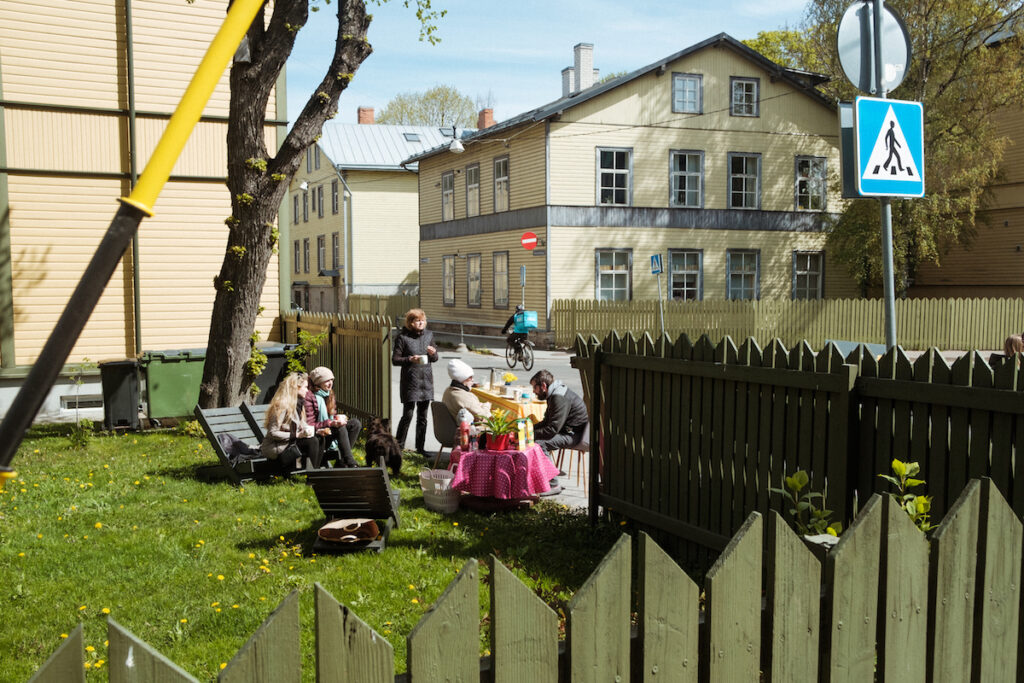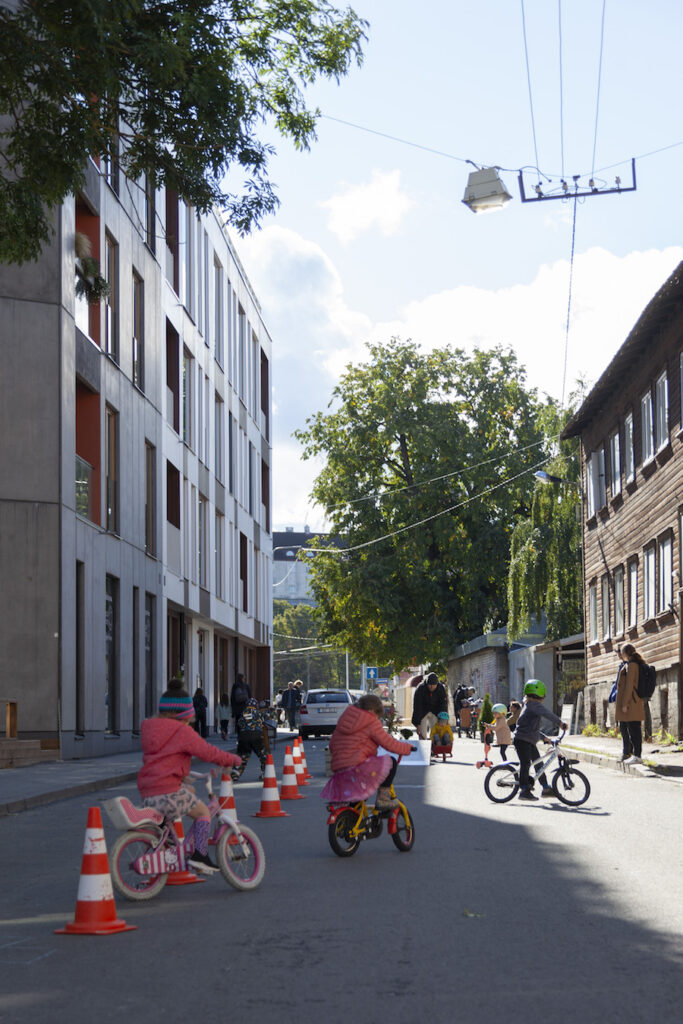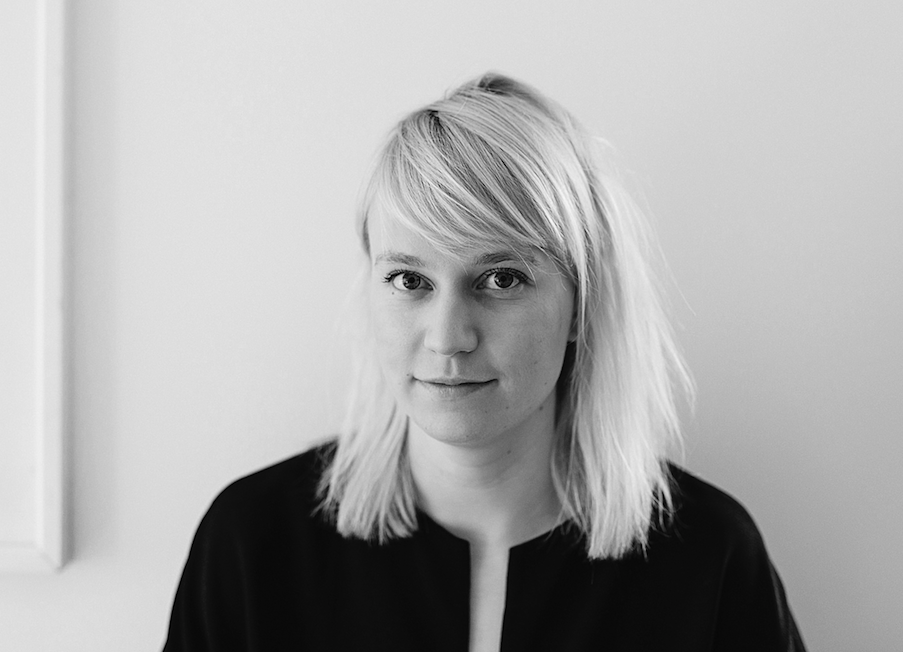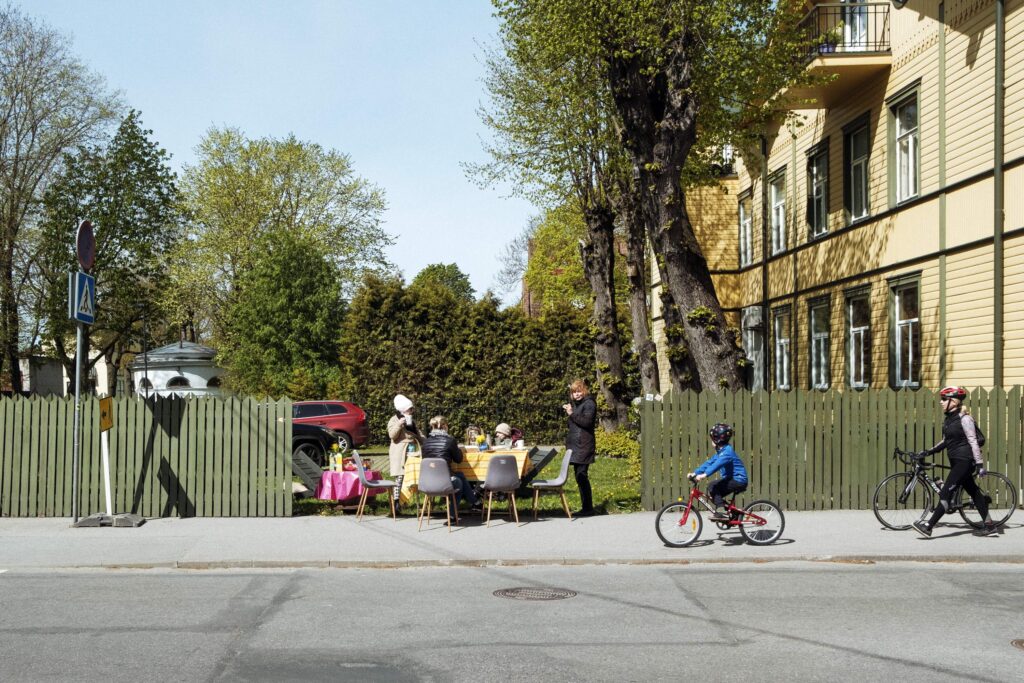Thinking of design as a service means bringing into focus the user and user needs. The impact of user-specificity is steadily increasing in how the processes of spatial design are approached. Ave Habakuk from the Living Street movement writes about how to think of the street as a service.
In spring of last year, we founded the Living Street movement, which stands for versatile urban space. The movement came into being during the corona-spring partially because quarantines were rapidly changing the world around us as well as our habitual use of exterior space, and we were irritated by the reluctance of our cosy Tallinn urban environment to keep up with the changing needs. While Vilnius was quick to grasp that the streets of old town needed to transform into a huge open-air cafeteria to support the mental health of the residents as well as local entrepreneurship, or while Berlin and Paris started to create pop-up bicycle lanes to enable contact-free mobility, our local streetscape kept ticking in the old way as if the world around us hadn’t changed at all.
At Living Street, which has been operating for a year and a half now, we have been asking what a street as such could offer us beyond the status quo. In our practice, we use a method of service design where we first study the issue (often using techniques that originate in anthropology), after which we identify the root or focal cause of the issue, which then populates different solutions that are tested and perfected in collaboration with users before being implemented in public space. Service design is inclusive by nature: it is very risky to try and reach a good solution without understanding the user and collaborating in the testing phase. In a well-orchestrated process of service design, the service-provider develops empathy for the end users, but it is in co-creating and joint exploration of new possibilities where trust is seeded within the users, so that a feeling of coherence and motivation to use the service can flourish.

Service for learning to move
We tested a spatial design method that started with picking user experience of street use and continued with the help of mobility experts by filtering out problem clusters and finding potential solutions to them. For example, one experience picking led to an idea that perhaps streets around kindergartens could be enhanced with small balancing beams or simpler climbing affordances that would make the streetscape more exciting for children and inspire them to move on foot. This could make the street part of the solution to the issue of pre-schoolers being too tired or not wanting to walk. A playful street as a service to support parents!
Thinking of the street as a service enables a new type of flexibility and multidimensionality: the one and the same street can simultaneously be supporting various functions and offering different use methods. Changing the streetscape does not necessarily require construction work, even the power of the word, colour, or temporary beacons are enough to change the content of the service.
On three Sundays in the autumn, we tested the possibility of creating temporary playgrounds at different locations around Tallinn. We made slight adjustments to traffic control on a sleepy street on a Sunday by closing it to cars but enabling locals to drive to their homes, and by using simple methods opened the street for play and get-togethers. The sleepiness was replaced by fun and joy: the street became a place that invited people to stay and possibilities that are normally sought in playgrounds, cafes or gyms were offered right under their home windows. By rush hour on Monday when everybody was back to being busy and important, cars were rolling in the street once again.

Bus stop—a structure or a service?
In the midst of all this play we must not forget the main thing — mobility service. Next to driving lanes and sidewalks, the quality and availability of mobility services are influenced by objects on the streets, such as bus stops1. One way to feel the pulse of change as an urban space activist is to keep track of current streetscape-related procurements. A recent thought-provoking find was a project for the renovation of four bus stops in Tallinn, and the text began with: ’The purpose of the project is to design and reconstruct three bus stops in the central City district of Tallinn: at Tallinn University, Tõnismäe, Mere Blvd, and Liberty Square.’2 Everything seems very simple, we can all imagine a bus stop. Let’s build as big a standardised waiting pavilion as the street can fit, add a bench and a bus stop sign.
Putting on our service designer cap arises questions which, if left unanswered, render a helpful solution difficult to find. Who are the expected users of these stops? What are the start and end points of their journeys? How do they access the stop? Do they have to wait long at the stop? Appendix 1 of the procurement is a thorough list of engineering-specific conditions but does not entail a word about the profiles of the users or what the bus stop should enable doing.

Answers to questions as these could have a major impact on the spatial solution of a bus stop, decisions made during its build, and through its overall usability. For example, if many school children use it, the timetables could be positioned at an appropriate height, or if it turns out middle-aged men are less likely to use it, one may ask how the mobility of that specific user group could be better supported by public transportation.
If we only account for technical requirements in the design and construction of a bus stop, we might not consider the actual needs of people in the best way possible. Most of the applications, objects, and services that we consider comfortable and pleasant are user-friendly because they have been developed and designed based on user needs. Therefore, competition is tight and services ignorant to user needs are progressing towards their demise, among them the public transport service of Tallinn with decreasing user population3.

A new kind of reality
An example from our Nordic neighbours is one where careful consideration of the services of a public space object brought about its exceptional popularity. The new building of the central library of Helsinki, the Oodi, opened in 2018. The library was built based on an evaluation that approximately 2.5 million people would visit it annually, but the number of visitors in the first year alone was 3.1 million4. The articles published in Estonian around the time of its opening make abundant mention of ALA Architects, but the role of service design in the maturation of the Oodi has been left out5.
The service designer of the Oodi, Virve Hyysalo in her doctoral thesis elucidates the process of service development preceding the vernissage of the library, in which the intention was to bring the central library into the awareness of as many people as possible and ways were sought to expand the typical user groups of the library6.
ALA Architects won the competition in 2013, but co-creative service design processes had begun a year earlier. The co-creation of the Oodi between the citizens and the partners focused on the planning of the services, functions, and customer experience of the library, within the context of a broader discussion on what we expect and need out of a contemporary library7. The Oodi library is a remarkable example of how a physical object carved in stone and matured over time has been re-invented from a service-specific perspective, offering new and contemporary knowledge and experience to the citizens.
We might ask the same about our streets and even bus stops, if larger structures seem too far out of reach. Streets are so much more than just space between buildings. Using service design as a tool in the design of our streetscapes helps to see beyond physical objects and provides us the opportunity to re-inform our approach to the use of space, notice the shortcomings, and with the help of fast and temporary as well as slow and more durable means change the space to be supportive of intended behaviours. A user-specific view enables flexibility and to notice when change is necessary to keep up with time, and invent new, joyful, and surprising spatial solutions.

AVE HABAKUK is one of the co-founders of Living Street, and a Master’s student at the Applied Behavioural Sciences School of Tartu University. Ave works as a service designer in the public sector.
HEADER photo by Joosep Kivimäe
PUBLISHED: Maja 111 (winter 2023) with main topic Street Unrest
1 Spin Unit, Demos Helsinki, ‘Peatuskoht: põhisõnumid ja kokkuvõte. Tallinna ja Harjumaa ühissõidukipeatuste uuring: peatuste roll jätkusuutlike ja võrdsete liikumisvõimaluste toetamisel’, 2022, https://www.hol.ee/docs/file/PeatusKOHT_Uuringu%20kokkuvõte%20ja%20põhisõnumid.pdf.
2 ‘Bussipeatuste projekteerimine ja ümberehitamine’, riigihangete register, https://riigihanked.riik.ee/rhr-web/#/procurement/4933680/documents/source-document?group=B&documentOldId=15587207.
3 ‘Liikuvuse statistika’, transpordiamet, https://transpordiamet.ee/liikuvuse-statistika.
4 ‘Helsinki Central Library Oodi’, Design Helsinki, https://design.hel.fi/en/design-stories/central-library-oodi/.
5 Kai Aarelaid, ‘Oodi – elutuba keset Helsingit’, Sirp, December 12, 2018, https://www.sirp.ee/s1-artiklid/c7-kirjandus/oodi-elutuba-keset-helsingit;
Urmas Saard, Kärt Saard, ‘Oodi on olnud avatud kolm kuud’, Külauudised, https://kylauudis.ee/2019/03/06/oodi-on-olnud-avatud-kolm-kuud/; Tarja Nurmi, ‘Üks sissevaade Soome arhitektuurile’, Sirp, December 1, 2017, https://www.sirp.ee/s1-artiklid/arhitektuur/uks-sisevaade-soome-arhitektuurile/.
6 Virve Hyysalo, ‘Yhteissuunnittelu ja palvelumuotoilu julkisen sektorin kehityssuuntina: kaupunkilaiset tekijöinä, käyttäjinä ja kumppaneina keskustakirjasto Oodin suunnittelussa’, 2022,
https://urn.fi/URN:ISBN:978-952-337-308-2.
7 ‘Helsingin kaupunginkirjaston satusynttärit varattiin vain puolessa tunnissa’, Helsinkin Sanomat, https://www.hs.fi/kaupunki/art-2000002674758.html.





